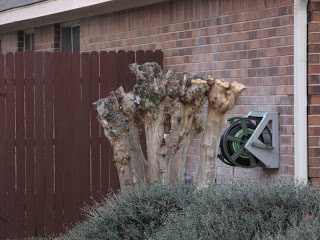
This winter I've found myself thinking a lot about my grandmother. It took me a while to realize what was triggering the memories, but I finally realized it was two things: purple pansies and crape myrtles.
We lived in the Mojave Desert when I was a child, and Grandma always kept a bed of purple petunias growing in front of the house. Given the heat, the sand, and the lack of available moisture and nutrients, you can imagine how much fussing she must have done over those straggly plants to produce blooms. She really wanted violets, but learned to settle for and appreciate her pet petunias. They were unfailingly deep purple - as if they didn't come in any other color.
Here in Texas, winter is an ideal time to enjoy pansies. (I know - pansies, not petunias.) You see them mass planted in commercial landscapes and popping out of pots on front porches all over town - the masses of color almost always including Grandma's purple. So, I think of her and how much she would have enjoyed them.
We also seem to have a fondness in central Texas for crape myrtles. My particular neighborhood is thick with them. This time of year much of their foliage is gone, and sometimes we have an opportunity to appreciate their silvery smooth, mottled bark and their stark outlines against the sky. I say "sometimes" because it seems that at some point in the distant past it became "common knowledge" that one should cut them way back. It probably started with one landscaping company, and observers decided it just must be the way "experts" took care of them.

It always reminds me of the story about the proper way to cook a roast. A family of good cooks thought you always cut the roast in half before you put it in the pan. That's the way the matriarch of the family had always done it, and it was the best tasting roast they could imagine. One year, that same matriarch was in the kitchen during the preparation of the roast and asked why they were cutting it in half. When they said it was because she had always done it that way, she replied that was only because the pan she had was too small and she had to cut the meat to make it fit.

The truth is that these crape crew cuts don't just look bad, they don't support the health of the tree. How we choose to prune them affects not only the shape, but the vigor and soundness of the tree. Topping, as these crew cuts are called, produces numerous new shoots that develop rapidly. That sounds good, you say, as the tree will appear bushy. However, the new shoots form weak attachments to the main trunk and tend to be less healthy. The number of leaves is reduced, and thereby the trees' ability to produce food energy through photosynthesis. Weaker trees are more susceptible to attack by insects and disease, and can result in early death. In mature trees, large pruning cuts are slower to heal and more vulnerable to decay. 


So, why do crape myrtles remind me of my grandmother? We lived in the Mojave Desert because the warm, dry climate was supposed to be good for the crippling arthritis she lived with all her life. When I see those knobby, misshapen knuckles topping crape myrtles, I feel an urge to soothe them - just as I felt when I saw my grandmother's hands.
Here's some reliable information from the AggieHorticulture website on proper techniques for crape myrtle care:
They don't need to be pruned to flower. However, proper thinning will open up the growth of the tree and allow air circulation. This will reduce the possibility of powdery mildew growth. You should wait until early spring to thin, as trees cut in December through February suffer greater winter damage. Don't cut any wood thicker than a pencil. And, remember. With proper care, some of these trees naturally grow to a statuesque height of 35 feet. See the very first photo for a glimpse of how beautiful a stand of well cared for crape myrtles can be. Grandma would've loved them. Especially the purple flowered ones.
Comments